
St Bartholomew's Church is a parish church of the Church of England Diocese of Truro in Lostwithiel, Cornwall, England, United Kingdom.

Lanlivery is a village and civil parish in Cornwall, England, United Kingdom. The village is about 1+1⁄2 miles (2.4 km) west of Lostwithiel and five miles (8 km) south of Bodmin. The Saints' Way runs past Lanlivery. Helman Tor, Red Moor and Breney Common nature reserves lie within the parish.

St Winnow is a civil parish in Cornwall, England, United Kingdom. Its name may be connected with either that of Saint Winnoc or Saint Winwaloe. It has a population of 304, which had increased to 328 at the 2011 census. The church town is on the east bank of the River Fowey south of Lostwithiel. Part of the village of Lerryn lies within the parish as does the Chapel of St Nectan. The Redlake Meadows & Hoggs Moor, a Site of Special Scientific Interest is also in the parish.

The Church of St Morwenna and St John the Baptist is the parish church of Morwenstow, north Cornwall, England, United Kingdom, the most northerly parish in Cornwall. The church is dedicated to Morwenna, a local saint, and to John the Baptist, and is recorded in the National Heritage List for England as a designated Grade I listed building. It is an active Anglican parish church in the diocese of Truro, the archdeaconry of Bodmin, and the deanery of Stratton. Its benefice is combined with that of St James, Kilkhampton to form the United Benefice of Kilkhampton with Morwenstow.
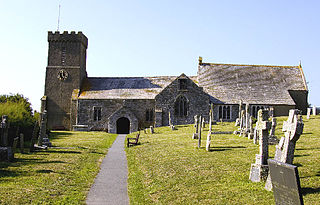
St Carantoc's Church, Crantock is in the village of Crantock, Cornwall, England. Since 1951 the church has been designated as a Grade I listed building. It is an active Anglican parish church in the diocese of Truro, the archdeaconry of Cornwall and the deanery of Pydar. Its benefice is combined with that of St Cubert.
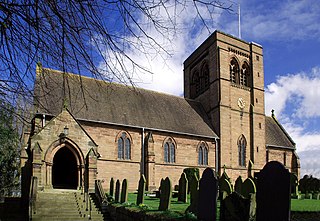
St John the Evangelist's Church stands to the west of the village of Norley, Cheshire, England. The church is recorded in the National Heritage List for England as a designated Grade II* listed building. It is an active Anglican parish church in the diocese of Chester, the archdeaconry of Chester and the deanery of Frodsham. Its benefice is combined with those of Christ Church, Crowton, and St John the Evangelist, Kingsley.

The Church of St Gregory Stoke St Gregory, is a Church of England parish church in Somerset, England. Its parish is part of the Athelney Benefice, along with the parishes of St Michael, Burrowbridge, St Bartholomew, Lyng and SS Peter and Paul, North Curry.

The Church of Saint Laudus is an active parish church in Mabe, Cornwall, England, UK, originally built in the 15th century and dedicated to the sixth-century Saint Laudus of Coutances. It is part of the Church of England Diocese of Truro. Struck by lightning in the 19th century, much of it had to be rebuilt, though parts of the original church remain. It has been a Grade II* listed building since 10 July 1957.

St Swithun's Church is a historic Anglican church in the village of Brookthorpe, Gloucestershire, England under the care of The Churches Conservation Trust. It is recorded in the National Heritage List for England as a designated Grade II* listed building.

All Saints Church is in the village of Berrington, Shropshire, England. It is an active Anglican parish church in the deanery of Condover, the archdeaconry of Ludlow, and the diocese of Hereford. Its benefice is united with those of twelve other parishes to form the Wenlock Team of Parishes. The church is recorded in the National Heritage List for England as a designated Grade I listed building.
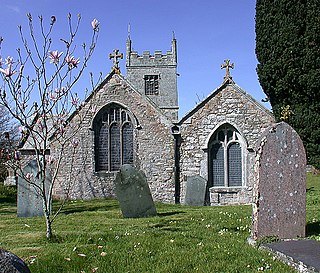
Colan Church also known as St Colan Church is a 13th-century church in Colan, mid-Cornwall, UK. Dedicated to St Colanus, it became a Grade I listed building in 1967. The vicars of St Columb Minor have served the church since the middle of the 20th century.

St Luke's Church is in the village of Hodnet, Shropshire, England. It is an active Anglican parish church in the deanery of Hodnet, the archdeaconry of Salop, and the diocese of Lichfield. Its benefice is united with those of The Epiphany, Peplow, and St Luke, Weston under Redcastle. The church is recorded in the National Heritage List for England as a designated Grade I listed building. It overlooks the park of Hodnet Hall.

St Piran's Church is an active Anglican parish church in Perranarworthal, Cornwall, England. It is part of a united benefice consisting of eight churches, the Eight Saints Cluster, in the parishes of Stithians with Perran-Ar-Worthal and Gwennap. The benefice has four licensed clergy and four readers. The church, dedicated to Saint Piran, is in the Carnmarth, North deanery, the archdeaconry of Cornwall and the Diocese of Truro. The church was granted Grade II* listed status in May 1967. The churchyard contains several listed chest tombs and headstones.
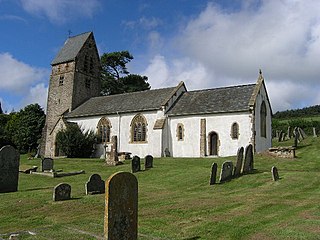
The Anglican St Mary's Church at Luxborough within the English county of Somerset dates from the 13th century. It is a Grade II listed building.

Boconnoc Church is a Grade I listed Church of England parish church in Boconnoc, Cornwall.

The Church of St James is a Grade I listed 12th-century Anglican parish church in Antony, Cornwall, England.

St Columba's Church is a 14th-century, Grade I listed parish church in the Church of England Diocese of Truro in St Columb Major, Cornwall. In 1860 plans were drawn up by William Butterfield, in hope of St Columb church becoming the cathedral of the future diocese of Cornwall, but the cathedral was built at Truro. A second church dedicated to the same saint is known as St Columba's Church, St Columb Minor.

St Cyricius and St Julietta's Church, St Veep is a Grade I listed parish church of Church of England in St Veep, Cornwall.

St Germanus' Church is a Church of England church in Rame, Cornwall, England, UK. Much of the existing church dates to the 13th and 15th centuries. It has been Grade I listed since 1960.
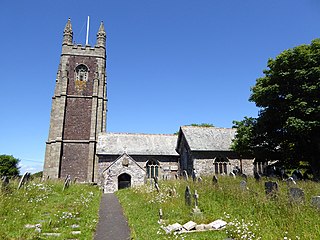
St Mary's and St Julian's Church is a Church of England parish church in Maker, Cornwall, England, UK. The church dates to the 15th century and has been a Grade I listed building since 1968.





















